Cinnamon
Cinnamon (/ˈsɪnəmən/ SIN-ə-mən) is a spice obtained from the inner bark of several tree species from the genus Cinnamomum. Cinnamon is used mainly as an aromatic condiment and flavouring additive in a wide variety of cuisines, sweet and savoury dishes, breakfast cereals, snackfoods, tea and traditional foods. The aroma and flavour of cinnamon derive from its essential oil and principal component, cinnamaldehyde, as well as numerous other constituents, including eugenol.
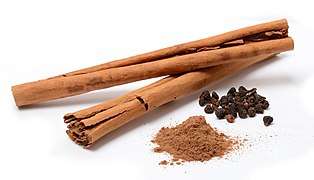
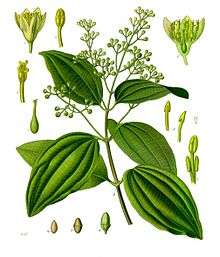

The term "cinnamon" also is used to describe its mid-brown colour. Cinnamon is the name for several species of trees and the commercial spice products that some of them produce. All are members of the genus Cinnamomum in the family Lauraceae.[1] Only a few Cinnamomum species are grown commercially for spice. Cinnamomum verum is sometimes considered to be "true cinnamon", but most cinnamon in international commerce is derived from related species, also referred to as "cassia".[2][3] In 2016, Indonesia and China produced 75% of the world's supply of cinnamon.
Etymology
The English word "cinnamon", attested in English since the fifteenth century, derives from the Greek κιννάμωμον kinnámōmon (later kínnamon), via Latin and medieval French intermediate forms. The Greek was borrowed from a Phoenician word, which was similar to the related Hebrew קינמון (qinamon).[4]
The name "cassia", first recorded in English around AD 1000, was borrowed via Latin and ultimately derives from Hebrew q'tsīʿāh, a form of the verb qātsaʿ, "to strip off bark".[5]
Early Modern English also used the names canel and canella, similar to the current names of cinnamon in several other European languages, which are derived from the Latin word cannella, a diminutive of canna, "tube", from the way the bark curls up as it dries.[6]
History
Ancient history
Cinnamon has been known from remote antiquity. It was imported to Egypt as early as 2000 BC, but those who report that it had come from China confuse it with cassia.[3] Cinnamon was so highly prized among ancient nations that it was regarded as a gift fit for monarchs and even for a deity; a fine inscription records the gift of cinnamon and cassia to the temple of Apollo at Miletus.[7] Although its source was kept mysterious in the Mediterranean world for centuries by those in the spice trade to protect their monopoly as suppliers, cinnamon is native to India, Sri Lanka, Bangladesh, and Myanmar.[8]
The first Greek reference to kasia is found in a poem by Sappho in the seventh century BC. According to Herodotus, both cinnamon and cassia grew in Arabia, together with incense, myrrh, and labdanum, and were guarded by winged serpents.
In Ancient Egypt, cinnamon was used to embalm mummies.[9] From Hellenistic times onward, Ancient Egyptian recipes for kyphi, an aromatic used for burning, included cinnamon and cassia. The gifts of Hellenistic rulers to temples sometimes included cassia and cinnamon.
Cinnamon was brought around the Arabian peninsula on "rafts without rudders or sails or oars", taking advantage of the winter trade winds.[10] Pliny the Elder also mentions cassia as a flavouring agent for wine.[11]
According to Pliny the Elder, a Roman pound (327 grams (11.5 oz)) of cassia, cinnamon, or serichatum cost up to 1500 denarii, the wage of fifty months' labour.[12] Diocletian's Edict on Maximum Prices[13] from 301 AD gives a price of 125 denarii for a pound of cassia, while an agricultural labourer earned 25 denarii per day. Cinnamon was too expensive to be commonly used on funeral pyres in Rome, but the Emperor Nero is said to have burned a year's worth of the city's supply at the funeral for his wife Poppaea Sabina in AD 65.[14]
Malabathrum leaves (folia) were used in cooking and for distilling an oil used in a caraway sauce for oysters by the Roman gourmet, Gaius Gavius Apicius.[15] Malabathrum is among the spices that, according to Apicius, any good kitchen should contain.
Middle Ages
Through the Middle Ages, the source of cinnamon remained a mystery to the Western world. From reading Latin writers who quoted Herodotus, Europeans had learned that cinnamon came up the Red Sea to the trading ports of Egypt, but where it came from was less than clear. When the Sieur de Joinville accompanied his king to Egypt on crusade in 1248, he reported – and believed – what he had been told: that cinnamon was fished up in nets at the source of the Nile out at the edge of the world (i.e., Ethiopia). Marco Polo avoided precision on the topic.[16] Herodotus and other authors named Arabia as the source of cinnamon: they recounted that giant "cinnamon birds" collected the cinnamon sticks from an unknown land where the cinnamon trees grew and used them to construct their nests, and that the Arabs employed a trick to obtain the sticks. Pliny the Elder wrote in the first century that traders had made this up to charge more, but the story remained current in Byzantium as late as 1310.
The first mention that the spice grew in Sri Lanka was in Zakariya al-Qazwini's Athar al-bilad wa-akhbar al-‘ibad ("Monument of Places and History of God's Bondsmen") about 1270.[17] This was followed shortly thereafter by John of Montecorvino in a letter of about 1292.[18]
Indonesian rafts transported cinnamon directly from the Moluccas to East Africa (see also Rhapta), where local traders then carried it north to Alexandria in Egypt.[19][20][21] Venetian traders from Italy held a monopoly on the spice trade in Europe, distributing cinnamon from Alexandria. The disruption of this trade by the rise of other Mediterranean powers, such as the Mamluk sultans and the Ottoman Empire, was one of many factors that led Europeans to search more widely for other routes to Asia.
Early modern period
During the 1500s, Ferdinand Magellan was searching for spices on behalf of Spain, and in the Philippines found Cinnamomum mindanaense, which was closely related to C. zeylanicum, the cinnamon found in Sri Lanka. This cinnamon eventually competed with Sri Lankan cinnamon, which was controlled by the Portuguese.[22]
In 1638, Dutch traders established a trading post in Sri Lanka, took control of the manufactories by 1640, and expelled the remaining Portuguese by 1658. "The shores of the island are full of it," a Dutch captain reported, "and it is the best in all the Orient. When one is downwind of the island, one can still smell cinnamon eight leagues out to sea."[23]:15 The Dutch East India Company continued to overhaul the methods of harvesting in the wild and eventually began to cultivate its own trees.
In 1767, Lord Brown of the British East India Company established Anjarakkandy Cinnamon Estate near Anjarakkandy in the Cannanore district of Kerala; it became Asia's largest cinnamon estate. The British took control of Ceylon from the Dutch in 1796.
Cultivation
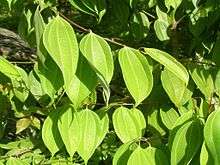
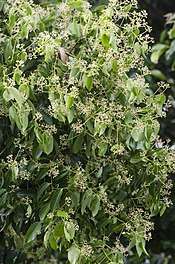
Cinnamon is an evergreen tree characterized by oval-shaped leaves, thick bark, and a berry fruit. When harvesting the spice, the bark and leaves are the primary parts of the plant used.[9] Cinnamon is cultivated by growing the tree for two years, then coppicing it, i.e., cutting the stems at ground level. The following year, about a dozen new shoots form from the roots, replacing those that were cut. A number of pests such as Colletotrichum gloeosporioides, Diplodia spp., and Phytophthora cinnamomi (stripe canker) can affect the growing plants.[24]
The stems must be processed immediately after harvesting while the inner bark is still wet. The cut stems are processed by scraping off the outer bark, then beating the branch evenly with a hammer to loosen the inner bark, which is then pried off in long rolls. Only 0.5 mm (0.02 in) of the inner bark is used; the outer, woody portion is discarded, leaving metre-long cinnamon strips that curl into rolls ("quills") on drying. The processed bark dries completely in four to six hours, provided it is in a well-ventilated and relatively warm environment. Once dry, the bark is cut into 5 to 10 cm (2 to 4 in) lengths for sale. A less than ideal drying environment encourages the proliferation of pests in the bark, which may then require treatment by fumigation. Fumigated bark is not considered to be of the same premium quality as untreated bark.
Species
A number of species are often sold as cinnamon:[25]
- Cinnamomum cassia (cassia or Chinese cinnamon, the most common commercial type)
- C. burmannii (Korintje, Padang cassia, or Indonesian cinnamon)
- C. loureiroi (Saigon cinnamon, Vietnamese cassia, or Vietnamese cinnamon)
- C. verum (Sri Lanka cinnamon or Ceylon cinnamon)
- C. citriodorum (Malabar cinnamon)
- C. tamale (Indian cinnamon)
Cassia induce a strong, spicy flavour and is often used in baking, especially associated with cinnamon rolls, as it handles baking conditions well. Among cassia, Chinese cinnamon is generally medium to light reddish brown in colour, hard and woody in texture, and thicker (2–3 mm (0.079–0.118 in) thick), as all of the layers of bark are used. Ceylon cinnamon, using only the thin inner bark, has a lighter brown colour, a finer, less dense and more crumbly texture. It is considered to be subtle and more aromatic in flavour than cassia and it loses much of its flavour during cooking.
The barks of the species are easily distinguished when whole, both in macroscopic and microscopic characteristics. Ceylon cinnamon sticks (quills) have many thin layers and can easily be made into powder using a coffee or spice grinder, whereas cassia sticks are much harder. Indonesian cinnamon is often sold in neat quills made up of one thick layer, capable of damaging a spice or coffee grinder. Saigon cinnamon (C. loureiroi) and Chinese cinnamon (C. cassia) are always sold as broken pieces of thick bark, as the bark is not supple enough to be rolled into quills.
The powdered bark is harder to distinguish, but if it is treated with tincture of iodine (a test for starch), little effect is visible with pure Ceylon cinnamon, but when Chinese cinnamon is present, a deep-blue tint is produced.[26][27]
Grading
The Sri Lankan grading system divides the cinnamon quills into four groups:
- Alba, less than 6 mm (0.24 in) in diameter
- Continental, less than 16 mm (0.63 in) in diameter
- Mexican, less than 19 mm (0.75 in) in diameter
- Hamburg, less than 32 mm (1.3 in) in diameter
These groups are further divided into specific grades. For example, Mexican is divided into M00 000 special, M000000, and M0000, depending on quill diameter and number of quills per kilogram.
Any pieces of bark less than 106 mm (4.2 in) long are categorized as quillings. Featherings are the inner bark of twigs and twisted shoots. Chips are trimmings of quills, outer and inner bark that cannot be separated, or the bark of small twigs.
Production
| Country | (tonnes) |
|---|---|
Combined, Indonesia and China produced 75% of the world's cinnamon in 2016 when global production was 223,574 tonnes (table). Four countries accounted for 99% of the world total: Indonesia, China, Vietnam, and Sri Lanka.[28]
Food uses
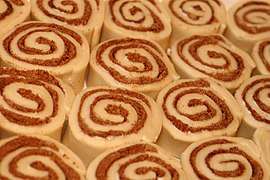
Cinnamon bark is used as a spice. It is principally employed in cookery as a condiment and flavouring material. It is used in the preparation of chocolate, especially in Mexico. Cinnamon is often used in savoury dishes of chicken and lamb. In the United States, cinnamon and sugar are often used to flavour cereals, bread-based dishes, such as toast, and fruits, especially apples; a cinnamon-sugar mixture is sold separately for such purposes. It is also used in Turkish cuisine for both sweet and savoury dishes. Cinnamon can also be used in pickling and Christmas drinks such as eggnog. Cinnamon powder has long been an important spice in enhancing the flavour of Persian cuisine, used in a variety of thick soups, drinks, and sweets.[29]:10–12
Nutrition
| Nutritional value per 100 g (3.5 oz) | |
|---|---|
| Energy | 247 kJ (59 kcal) |
|
80.6 g | |
| Sugars | 2.2 g |
| Dietary fiber | 53.1 g |
|
1.2 g | |
|
4 g | |
| Vitamins | Quantity %DV† |
| Vitamin A equiv. |
2% 15 μg |
| Thiamine (B1) |
2% 0.02 mg |
| Riboflavin (B2) |
3% 0.04 mg |
| Niacin (B3) |
9% 1.33 mg |
| Vitamin B6 |
12% 0.16 mg |
| Folate (B9) |
2% 6 μg |
| Vitamin C |
5% 3.8 mg |
| Vitamin E |
15% 2.3 mg |
| Vitamin K |
30% 31.2 μg |
| Minerals | Quantity %DV† |
| Calcium |
100% 1002 mg |
| Iron |
64% 8.3 mg |
| Magnesium |
17% 60 mg |
| Phosphorus |
9% 64 mg |
| Potassium |
9% 431 mg |
| Sodium |
1% 10 mg |
| Zinc |
19% 1.8 mg |
| Other constituents | Quantity |
| Water | 10.6 g |
|
| |
| |
|
†Percentages are roughly approximated using US recommendations for adults. Source: USDA Nutrient Database | |
Ground cinnamon is composed of around 11% water, 81% carbohydrates (including 53% dietary fiber), 4% protein, and 1% fat (table). Typical serving size is one teaspoon or 2.6 grams).[30]
Flavour, aroma, and taste
The flavour of cinnamon is due to an aromatic essential oil that makes up 0.5 to 1% of its composition. This essential oil can be prepared by roughly pounding the bark, macerating it in sea water, and then quickly distilling the whole. It is of a golden-yellow colour, with the characteristic odour of cinnamon and a very hot aromatic taste. The pungent taste and scent come from cinnamaldehyde (about 90% of the essential oil from the bark) and, by reaction with oxygen as it ages, it darkens in colour and forms resinous compounds.[31]
Cinnamon constituents include some 80 aromatic compounds,[32] including eugenol found in the oil from leaves or bark of cinnamon trees.[33]
Alcohol flavourant
Cinnamon is used as a flavouring in some alcoholic beverages,[34] such as Fireball Cinnamon Whisky.
Cinnamon brandy concoctions, called "cinnamon liqueur" and made with distilled spirits, are popular in parts of Greece.
Traditional medicine
Cinnamon has a long history of use in traditional medicine. It has been tested on a variety of clinical conditions, including bronchitis and diabetes,[35] but there is no scientific evidence that consuming cinnamon has any health benefits.[36]
Toxicity
In 2008, The European Food Safety Authority considered toxicity of coumarin, a significant component of cinnamon, and confirmed a maximum recommended tolerable daily intake (TDI) of 0.1 mg of coumarin per kg of body weight. Coumarin is known to cause liver and kidney damage in high concentrations and metabolic effect in humans with CYP2A6 polymorphism.[37][38] Based on this assessment, the European Union set a guideline for maximum coumarin content in foodstuffs of 50 mg per kg of dough in seasonal foods, and 15 mg per kg in everyday baked foods.[39]
According to the maximum recommended TDI of 0.1 mg of coumarin per kg of body weight, which is 5 mg of coumarin for a body weight of 50 kg:
| Cinnamomum cassia | Cinnamomum verum | |
|---|---|---|
| milligrams of coumarin/kilograms of cinnamon | 100 mg – 12,180 mg/kg | less than 100 mg/kg |
| milligrams of coumarin/grams of cinnamon | 0.10 mg – 12.18 mg/g | less than 0.10 mg/g |
| TDI cinnamon at 50 kg body weight | 0.4 g – 50 g | more than 50 g |
Note: Due to the highly variable amount of coumarin in C. cassia, usually well over 1,000 mg of coumarin per kg of cinnamon and sometimes up to 12 times that, C. cassia has a very low safe intake level to adhere to the above TDI.[40]
A systematic review of adverse events resulted from cinnamon use reported gastrointestinal disorders and allergic reactions as the most frequent reported side effects.[41]
Gallery
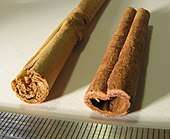 Quills of Ceylon cinnamon (Cinnamomum verum) on the left, and Indonesian cinnamon (Cinnamomum burmannii) on the right
Quills of Ceylon cinnamon (Cinnamomum verum) on the left, and Indonesian cinnamon (Cinnamomum burmannii) on the right Essential oil prepared from cinnamon bark
Essential oil prepared from cinnamon bark Besides use as flavourant and spice in foods, cinnamon-flavoured tea is consumed as a hot beverage
Besides use as flavourant and spice in foods, cinnamon-flavoured tea is consumed as a hot beverage.jpg) Cinnamon toast
Cinnamon toast Ferrara Pan Red Hots, a cinnamon-based candy
Ferrara Pan Red Hots, a cinnamon-based candy
See also
- Canella, a plant known as "wild cinnamon" or "white cinnamon"
- Cinnamomea, a New Latin adjective meaning "cinnamon-coloured"
- Cinnamon challenge
- List of culinary herbs and spices
References
- ↑

- ↑ Iqbal, Mohammed (1993). "International trade in non-wood forest products: An overview". FO: Misc/93/11 – Working Paper. Food and Agriculture Organization of the United Nations. Retrieved 12 November 2012.
- 1 2 Bell, Maguelonne Toussaint-Samat ; translated by Anthea (2009). A history of food (New expanded ed.). Chichester, West Sussex: Wiley-Blackwell. ISBN 978-1405181198.
Cassia, also known as cinnamon or Chinese cinnamon is a tree that has bark similar to that of cinnamon but with a rather pungent odour
- ↑ "cinnamon". Oxford English Dictionary (2nd ed.). Oxford University Press. 1989. ; also Harper, Douglas. "cinnamon". Online Etymology Dictionary. .
- ↑ "cassia". Oxford English Dictionary (2nd ed.). Oxford University Press. 1989. ; also Harper, Douglas. "cassia". Online Etymology Dictionary. .
- ↑ "canella; canel". Oxford English Dictionary (2nd ed.). Oxford University Press. 1989. .
- ↑ Toussaint-Samat 2009, p. 437
- ↑ "Cinnamon". Encyclopaedia Britannica. 2008. ISBN 1-59339-292-3.
(species Cinnamomum zeylanicum), bushy evergreen tree of the laurel family (Lauraceae) native to Malabar Coast of India, Sri Lanka (Ceylon) Bangladesh and Myanmar (Burma).
- 1 2 Burlando, B.; Verotta, L.; Cornara, L.; Bottini-Massa, E. (2010). Herbal principles in cosmetics: properties and mechanisms of action. Boca Raton: CRC Press. p. 121. ISBN 978-1-4398-1214-3.
- ↑ Pliny the Elder; Bostock, J.; Riley, H.T. (1855). "42, Cinnamomum. Xylocinnamum". Natural History of Pliny, book XII, The Natural History of Trees. 3. London: Henry G. Bohn. pp. 137–140.
- ↑ Pliny the Elder (1938). Natural History. Harvard University Press. p. 14. ISBN 978-0-674-99433-1.
- ↑ Pliny the Elder. Natural History. http://www.perseus.tufts.edu/hopper/text?doc=Perseus%3Atext%3A1999.02.0137%3Abook%3D12%3Achapter%3D42.
The right of regulating the sale of the cinnamon belongs solely to the king of the Gebanitæ, who opens the market for it by public proclamation. The price of it was formerly as much as a thousand denarii per pound; which was afterwards increased to half as much again, in consequence, it is said, of the forests having been set on fire by the barbarians, from motives of resentment[...]
- ↑ Graser, E. R. A text and translation of the Edict of Diocletian, in An Economic Survey of Ancient Rome, Volume V: Rome and Italy of the Empire. Johns Hopkins Press. 1940. ISBN 978-0374928483
- ↑ Toussaint-Samat 2009, p. 437f.
- ↑ De re coquinaria, I, 29, 30; IX, 7
- ↑ Toussaint-Samat 2009, p. 438 discusses cinnamon's hidden origins and Joinville's report.
- ↑ Tennent, Sir James Emerson. "Account of the Island of Ceylon". Retrieved 8 November 2014.
- ↑ Yule, Henry. "Cathay and the Way Thither". Retrieved 15 July 2008.
- ↑ "The life of spice; cloves, nutmeg, pepper, cinnamon |". UNESCO Courier. Findarticles.com. 1984. Archived from the original on 9 July 2012. Retrieved 18 August 2010.
- ↑ Independent Online. "News – Discovery: Sailing the Cinnamon Route (Page 1 of 2)". Iol.co.za. Archived from the original on 8 April 2005. Retrieved 18 August 2010.
- ↑ Gray, E. W.; Miller, J. I. (1970). "The Spice Trade of the Roman Empire 29 B.C. – A.D. 641". The Journal of Roman Studies. 60: 222–224. doi:10.2307/299440. JSTOR 299440.
- ↑ Mallari, Francisco (December 1974). "The Mindanao Cinnamon". Philippine Quarterly of Culture and Society. University of San Carlos Publications. 2 (4): 190–194. JSTOR 29791158.
- ↑ Braudel, Fernand (1984). The Perspective of the World. 3. University of California Press. p. 699. ISBN 0-520-08116-1.
- ↑ "Cinnamon". Plant Village, Pennsylvania State University. 2017. Retrieved 28 February 2017.
- ↑ Culinary Herbs and Spices, The Seasoning and Spice Association. Retrieved 3 August 2010.
- ↑ "A Modern Herbal – Cassia (Cinnamon)". www.botanical.com. Retrieved 17 April 2017.
- ↑ Pereira, Jonathan (1854). The Elements of materia medica and therapeutics. 2. p. 390.
- 1 2 "Global cinnamon production in 2016; Crops/Regions/World Regions/Production Quantity (pick lists)". UN Food and Agriculture Organization, Corporate Statistical Database (FAOSTAT). 2017. Retrieved 12 March 2018.
- ↑ Czarra, Fred (1 May 2009). Spices: A Global History. Reaktion Books. ISBN 9781861896827.
- ↑ "Cinnamon, spice, ground, per 100 g". US National Nutrient Database, Release 28, United States Department of Agriculture. May 2016. Retrieved 18 September 2017.
- ↑ Yokomi, Naoka; Ito, Michiho (1 July 2009). "Influence of composition upon the variety of tastes in Cinnamomi cortex". Journal of Natural Medicines. 63 (3): 261–266. doi:10.1007/s11418-009-0326-8. ISSN 1861-0293. PMID 19291358.
- ↑ Jayaprakasha, G. K.; Rao, L. J. (2011). "Chemistry, biogenesis, and biological activities of Cinnamomum zeylanicum". Critical Reviews in Food Science and Nutrition. 51 (6): 547–62. doi:10.1080/10408391003699550. PMID 21929331.
- ↑ "Oil of cinnamon". Toxicology Data Network (TOXNET). 6 August 2002. Retrieved 29 November 2016.
- ↑ Haley Willard (16 Dec 2013). "11 Cinnamon-Flavored Liquors for the Holidays". The Daily Meal. Retrieved 17 April 2017.
- ↑ Castro, M.D., M. Regina, Diabetes treatment: Can cinnamon lower blood sugar?, Mayo Clinic newsletter, 2018.03.12
- ↑ "Cinnamon". National Center for Complementary and Integrative Health, US National Institutes of Health. September 2016. Retrieved 28 February 2017.
- ↑ Harris, Emily. "German Christmas Cookies Pose Health Danger". National Public Radio. Retrieved 1 May 2007.
- ↑ "Coumarin in flavourings and other food ingredients with flavouring properties - Scientific Opinion of the Panel on Food Additives, Flavourings, Processing Aids and Materials in Contact with Food (AFC)". EFSA Journal. 6 (10): 793. 2008. doi:10.2903/j.efsa.2008.793.
- ↑ Russell, Helen (20 December 2013). "Cinnamon sparks spicy debate between Danish bakers and food authorities". The Guardian. ISSN 0261-3077. Retrieved 26 November 2016.
- ↑ Ballin, Nicolai Z.; Sørensen, Ann T. (2014). "Coumarin content in cinnamon containing food products on the Danish market" (PDF). Food Control. 38: 198. doi:10.1016/j.foodcont.2013.10.014.
- ↑ "Cinnamon: A systematic review of adverse events". doi:10.1016/j.clnu.2018.03.013. PMID 29661513.
Further reading
- Wijesekera R O B, Ponnuchamy S, Jayewardene A L, "Cinnamon" (1975) monograph published by CISIR, Colombo, Sri Lanka
External links
| Look up cinnamon in Wiktionary, the free dictionary. |
| Wikibooks Cookbook has a recipe/module on |
| Wikimedia Commons has media related to Cinnamomum verum. |